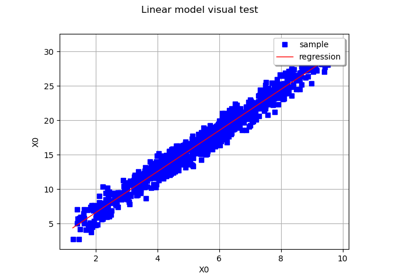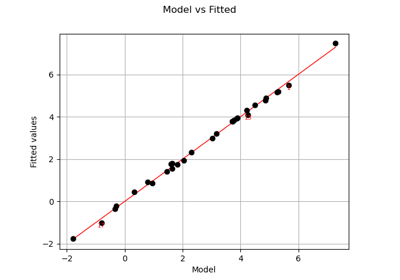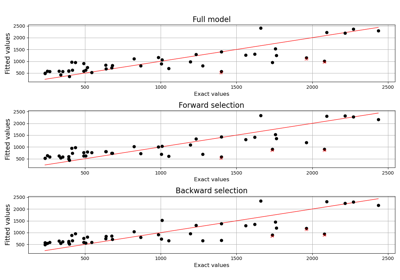LinearModelAlgorithm¶
- class LinearModelAlgorithm(*args)¶
Class used to create a linear model from numerical samples.
- Parameters:
- XSample2-d sequence of float
The input samples of a model.
- YSample2-d sequence of float
The output samples of a model, must be of dimension 1.
- basis
Basis Optional. The
basis .
See also
Notes
This class is used in order to create a linear model from data samples. The linear regression model between the scalar variable
and the
-dimensional vector
writes as follows:
where
is the residual, supposed to follow the standard Normal distribution,
a functional basis. The algorithm class enables to estimate the coefficients of the linear expansion.
If basis is not specified, the underlying model is :
The coefficients
are evaluated using a least squares method. Default method is QR. User might also choose SVD or Cholesky (useful if basis is orthogonal) and large dataset.
The evaluation of the coefficients is completed by some useful parameters that could help the diagnostic of the linearity.
Examples
>>> import openturns as ot >>> distribution = ot.Normal() >>> func = ot.SymbolicFunction(['x1','x2', 'x3'], ['x1 + x2 + sin(x2 * 2 * pi_)/5 + 1e-3 * x3^2']) >>> dimension = 3 >>> distribution = ot.ComposedDistribution([ot.Normal()]*dimension) >>> input_sample = distribution.getSample(20) >>> output_sample = func(input_sample) >>> algo = ot.LinearModelAlgorithm(input_sample, output_sample) >>> algo.run() >>> result = ot.LinearModelResult(algo.getResult())
Methods
BuildDistribution(inputSample)Recover the distribution, with metamodel performance in mind.
getBasis()Accessor to the input basis.
Accessor to the object's name.
Accessor to the joint probability density function of the physical input vector.
getId()Accessor to the object's id.
Accessor to the input sample.
getName()Accessor to the object's name.
Accessor to the output sample.
Accessor to the computed linear model.
Accessor to the object's shadowed id.
Accessor to the object's visibility state.
hasName()Test if the object is named.
Test if the object has a distinguishable name.
run()Compute the response surfaces.
setDistribution(distribution)Accessor to the joint probability density function of the physical input vector.
setName(name)Accessor to the object's name.
setShadowedId(id)Accessor to the object's shadowed id.
setVisibility(visible)Accessor to the object's visibility state.
- __init__(*args)¶
- static BuildDistribution(inputSample)¶
Recover the distribution, with metamodel performance in mind.
For each marginal, find the best 1-d continuous parametric model else fallback to the use of a nonparametric one.
The selection is done as follow:
We start with a list of all parametric models (all factories)
For each model, we estimate its parameters if feasible.
We check then if model is valid, ie if its Kolmogorov score exceeds a threshold fixed in the MetaModelAlgorithm-PValueThreshold ResourceMap key. Default value is 5%
We sort all valid models and return the one with the optimal criterion.
For the last step, the criterion might be BIC, AIC or AICC. The specification of the criterion is done through the MetaModelAlgorithm-ModelSelectionCriterion ResourceMap key. Default value is fixed to BIC. Note that if there is no valid candidate, we estimate a non-parametric model (
KernelSmoothingorHistogram). The MetaModelAlgorithm-NonParametricModel ResourceMap key allows selecting the preferred one. Default value is HistogramOne each marginal is estimated, we use the Spearman independence test on each component pair to decide whether an independent copula. In case of non independence, we rely on a
NormalCopula.- Parameters:
- sample
Sample Input sample.
- sample
- Returns:
- distribution
Distribution Input distribution.
- distribution
- getBasis()¶
Accessor to the input basis.
- Returns:
- basis
Basis The basis which had been passed to the constructor.
- basis
- getClassName()¶
Accessor to the object’s name.
- Returns:
- class_namestr
The object class name (object.__class__.__name__).
- getDistribution()¶
Accessor to the joint probability density function of the physical input vector.
- Returns:
- distribution
Distribution Joint probability density function of the physical input vector.
- distribution
- getId()¶
Accessor to the object’s id.
- Returns:
- idint
Internal unique identifier.
- getInputSample()¶
Accessor to the input sample.
- Returns:
- inputSample
Sample Input sample of a model evaluated apart.
- inputSample
- getName()¶
Accessor to the object’s name.
- Returns:
- namestr
The name of the object.
- getOutputSample()¶
Accessor to the output sample.
- Returns:
- outputSample
Sample Output sample of a model evaluated apart.
- outputSample
- getResult()¶
Accessor to the computed linear model.
- Returns:
- result
LinearModelResult The linear model built from numerical samples, along with other useful information.
- result
- getShadowedId()¶
Accessor to the object’s shadowed id.
- Returns:
- idint
Internal unique identifier.
- getVisibility()¶
Accessor to the object’s visibility state.
- Returns:
- visiblebool
Visibility flag.
- hasName()¶
Test if the object is named.
- Returns:
- hasNamebool
True if the name is not empty.
- hasVisibleName()¶
Test if the object has a distinguishable name.
- Returns:
- hasVisibleNamebool
True if the name is not empty and not the default one.
- run()¶
Compute the response surfaces.
Notes
It computes the response surfaces and creates a
MetaModelResultstructure containing all the results.
- setDistribution(distribution)¶
Accessor to the joint probability density function of the physical input vector.
- Parameters:
- distribution
Distribution Joint probability density function of the physical input vector.
- distribution
- setName(name)¶
Accessor to the object’s name.
- Parameters:
- namestr
The name of the object.
- setShadowedId(id)¶
Accessor to the object’s shadowed id.
- Parameters:
- idint
Internal unique identifier.
- setVisibility(visible)¶
Accessor to the object’s visibility state.
- Parameters:
- visiblebool
Visibility flag.
 OpenTURNS
OpenTURNS


